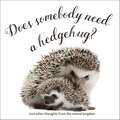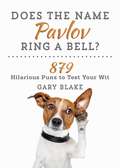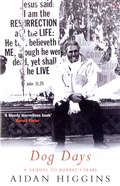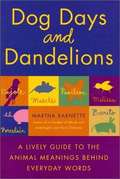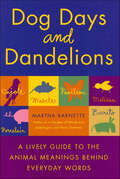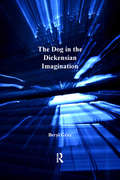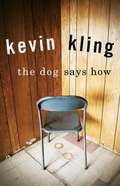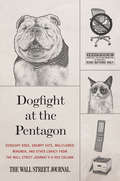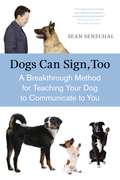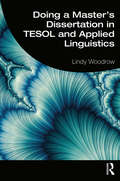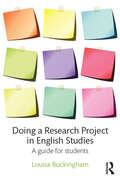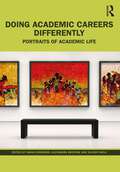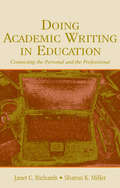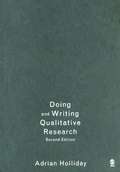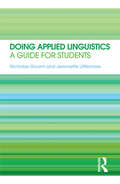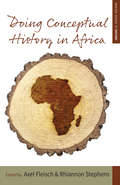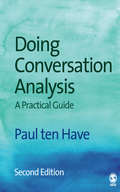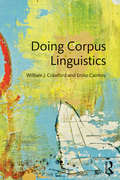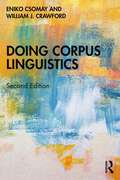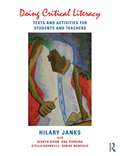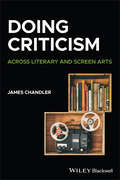- Table View
- List View
Does Somebody Need a Hedgehug?: And Other Thoughts from the Animal Kingdom
by Gibbs M. SmithQuack up your friends with this effortless gift.
Does the Name Pavlov Ring a Bell?: 879 Hilarious Puns to Test Your Wit
by Gary BlakeEveryone loves wordplay! This collection of more than eight hundred quips and pun-filled anecdotes will have your friends in stitches! Classics and new inventions fill these pages with humor and wit. Divided into chapters according to theme—animals, celebrities, careers, food, and so on—there’s a pun for every occasion! Author Gary Blake dares you not to snicker at his contrivances: Two silk worms had a race. They ended up in a tie. Davy Crockett had three ears. A left ear, a right ear, and a wild frontier. A backwards poet writes inverse. Santa’s helpers are subordinate Clauses. Like tavern owners, ballet dancers make most of their money at the barre. Horses in the movies only have bit parts. Why does the Pope travel so much? Because he’s a roamin’ Catholic. Absinthe makes the heart grow fonder. A Freudian slip is when you say one thing and mean your mother. Eve was the first person to eat herself out of house and home. I used to work in a blanket factory, but the company folded. The calendar thief only got twelve months. A great gift or coffee table book, there’s no time like the present to order a copy of Does the Name Pavlov Ring a Bell? for the word-twisting, pun-loving humorist in your life.
Does the New Testament Imitate Homer? Four Cases from the Acts of the Apostles
by Dennis Ronald MacdonaldIn this provocative challenge to prevailing views of New Testament sources, Dennis R. MacDonald argues that the origins of passages in the book of Acts are to be found not in early Christian legends but in the epics of Homer. MacDonald focuses on four passages in the book of Acts, examines their potential parallels in the Iliad, and concludes that the author of Acts composed them using famous scenes in Homer's work as a model. Tracing the influence of passages from the Iliad on subsequent ancient literature, MacDonald shows how the story generated a vibrant, mimetic literary tradition long before Luke composed the Acts. Luke could have expected educated readers to recognize his transformation of these tales and to see that the Christian God and heroes were superior to Homeric gods and heroes. Building upon and extending the analytic methods of his earlier book, The Homeric Epics and the Gospel of Mark, MacDonald opens an original and promising appreciation not only of Acts but also of the composition of early Christian narrative in general.
Dog Days
by Aidan Higgins'Tired of walking in the dream I have returned to the country where I was born half a century ago' - The Higgins family is now dispersed; the third son of four brothers is himself the father of three sons in a family also dispersed, and our author 'looking for the quietness that Julian Sorel found in prison. ' he finds this problematical peace, sharing a bungalow near Brittas in Co Wicklow in an awkward two year tenancy with a school mistress with back back trouble. DOG DAYS is an account of those two years, with flashbacks to previous diaries that reveal a murky Dublin of whores and Provo killing, a raindrenched Connemara.
Dog Days And Dandelions
by Martha BarnetteThe author does not recommend that this book be read all at once. But, I could not help myself. If there is an ox in the history of our English "A," (and there is) then how could I wait to find out where the other animals might be influencing my own use of words?
Dog Days and Dandelions: A Lively Guide to the Animal Meanings Behind Everyday Words
by Martha BarnetteFrom apian (like a bee) to zodiac (little-animals circle), a word book that spots the animal origins of words and namesThere are mice in your muscles, and blackbirds in your merlot. Behind adulation is a dog's wagging tail. Peculiar houses a herd of cattle. Grubby is crawling with bugs. Wordhound Martha Barnette collects more than 300 common (and a few not-so-common) words that have surprising animal roots. Tracing word origins back to ancient Greek and Latin as well as to European roots and American slang, the entries offer a guided tour through literature, science, folklore, politics, and more--with a wilderness of animal meanings at every turn.For fledgling word sleuths as well as those who fawn over etymologies, this is a delightful smorgasbord for writers, students, and word lovers.
Dog-eared: Poems About Humanity's Best Friend
by Duncan WuFrom Homer to Wordsworth to Gwendolyn Brooks, learn about history's greatest writers and the furry best friends that inspired them.Dogs are at once among the most ordinary of animals and the most beloved by mankind. But what we may not realize is that for as long as we have loved dogs, our poets have been seriously engaged with them as well.In this collection, English professor Duncan Wu digs into the wealth of poetry about our furry friends to show how varied and intimate our relationships with them have been over the centuries. Homer recounts how Odysseus's loyal dog recognizes his master even after his long absence. Thomas Hardy wrote poems from a pooch's perspective, conveying a powerful sense of dogs' innocent and trusting nature. And a multitude of writers, from Lord Byron to Emily Dickinson, have turned to poetry to mourn the loss of beloved dogs. Rich and inviting, Dog-eared is a spellbinding collection of poetic musings about humans and dogs and what they mean to each other.
The Dog in the Dickensian Imagination (The Nineteenth Century Series)
by Beryl GrayFascinated by them, unable to ignore them, and imaginatively stimulated by them, Charles Dickens was an acute and unsentimental reporter on the dogs he kept and encountered during a time when they were a burgeoning part of the nineteenth-century urban and domestic scene. As dogs inhabited Dickens’s city, so too did they populate his fiction, journalism, and letters. In the first book-length work of criticism on Dickens’s relationship to canines, Beryl Gray shows that dogs, real and invented, were intrinsic to Dickens’s vision and experience of London and to his representations of its life. Gray draws on an array of reminiscences by Dickens’s friends, family, and fellow writers, and also situates her book within the context of nineteenth-century attitudes towards dogs as revealed in the periodical press, newspapers, and institutional archives. Integral to her study is her analysis of Dickens’s texts in relationship to their illustrations by George Cruikshank and Hablot Knight Browne and to portraiture by late eighteenth- and nineteenth-century artists like Thomas Gainsborough and Edwin Landseer. The Dog in the Dickensian Imagination will not only enlighten readers and critics of Dickens and those interested in his life but will serve as an important resource for scholars interested in the Victorian city, the treatment of animals in literature and art, and attitudes towards animals in nineteenth-century Britain.
Dog on a Frog?
by Kes Gray Claire GrayFrog is turning the rules upside-down in this riotous, rhyming sequel to Frog on a Log?!"You know the rules," said cat. "Cats sit on mats, frogs sit on logs, and dogs sit on FROGS!""Well, I'm changing the rules," said the frog.In this hilarious sequel to Frog on a Log?, frog decides that he does not want to sit on a log, and he definitely does not want a dog to sit on a frog! So he changes the rules. Now, dogs sit on logs, and cats sit on gnats! But what will frog decide to sit on now? Chock-full of absurd animal rhyme pairings, Dog on a Frog? shows young readers that every animal has many special places to sit. Reminiscent of Dr. Seuss's Beginner Books, this sequel is a fun, educational read-aloud story that helps build reading skills!
The Dog Says How
by Kevin KlingIn this original collection of autobiographical stories, popular storyteller and NPR commentator Kevin Kling deftly weaves pitch-perfect scenes of childhood antics and adulthood absurdities with themes of overcoming tragedy, forging lifelong friendships, and living with disabilities in a complex world.
Dogfight at the Pentagon
by Wall Street JournalDiscover the story behind these and more in this delightful collection of the wild, the weird, and the wonderful, culled from The Wall Street Journal's popular and long-standing A-Hed column.One of the The Wall Street Journal's most popular features for more than seventy years, the daily A-Hed column--named for a headline that looked like a letter A--has diverted readers from the more glum news of war, economic woe, natural disasters, and man-made malfeasance. Covering a wide range of lunacy and the unusual from across the nation and the world, the A-Hed continues to enchant longtime readers.Now, the best A-Hed stories from recent years have been bundled into this entertaining volume. There are romantic tales, including the Japanese "infidelity phone" (it keeps trysts secret) and the story of "wingmen" and "wingwomen" who escort wallflowers to nightspots and maneuver them into the arms of prospective catches. Lovers of dogs, cats, and fish will learn how a Marine Corps bulldog got promoted to sergeant, how a grumpy cat acquired a Hollywood agent, and will be left wondering if a sixty-three-pound carp named Benson died of natural causes in England--or was the victim of foul play. Funny, moving, and charming, these stories will make you laugh and keep you entertained.
Dogs Can Sign, Too: A Breakthrough Method for Teaching Your Dog to Communicate
by Sean SenechalImagine being able to ask your poodle, "Who's at the door?" and having her respond, "It's Katy." Or asking your golden retriever, "Do you want a treat?" and him responding, "No, water." Or asking your Border collie, "Which toy do you want?" and getting the response, "Stick." If you've ever wondered what dogs would tell us if they could, now you can find out. The K9Sign system teaches dogs to communicate to us-making it a first in any dog training book category.Dogs Can Sign, Too is the first book dedicated exclusively to the K9Sign system for teaching dogs to communicate to their human companions using a vocabulary of gestures.This extraordinary education tool, developed by the creator of AnimalSign Language exclusively for the canine community, teaches people and their pets a unique mode of communication that employs an extensive lexicon of specific signs. Sample signs range from general concepts, such as "Food" or "Play" to identifying special treats, such as "Liver" or "Cheese" and specifying a favorite toy, such as "Ball" or "Frisbee." Signs also include useful questions such as "Who's that?" or "What type?" to naming a particular friend or family member, or even indicating a stranger. Learning and practicing K9Sign is a fun, challenging, and rewarding experience for both you and your dog that is sure to deepen the human-canine bond while expanding our ideas about interspecies communication.
Doing a Master's Dissertation in TESOL and Applied Linguistics
by Lindy WoodrowDoing a Master’s Dissertation in TESOL and Applied Linguistics is a practical guide for master’s students tackling research and research writing for the first time. Structured for use in class or as part of an independent study, and divided into the four stages of designing, researching, writing up and submitting a dissertation, this book: carefully guides readers from the very beginning of producing a research proposal, all the way through to assessment procedures and the provisions for resubmission; covers publishing your dissertation and applying for higher research degrees, including funding; addresses all the most fundamental concerns students have about master’s dissertations, including how to choose a topic and conducting a literature review; draws upon examples from master’s dissertations from the UK, US and Australia and provides numerous ‘how-to’ tables and checklists; and includes activities and resources to facilitate master’s research and dissertation writing, as well as FAQs and solutions at the end of each chapter. Tailormade for MA students in TESOL or Applied Linguistics, this book is essential reading for students on these degrees around the world as well as for their supervisors and programme directors.
Doing a Research Project in English Studies: A guide for students
by Louisa BuckinghamDoing a Research Project in English Studies is the essential guide to undertaking research and developing academic English literacy skills for students new to research. With a particular focus on the needs of students in contexts where English is used as a foreign or an additional language, this accessible textbook takes the reader through the research process in five main sections: getting started (arriving at a topic, interacting with a supervisor); finding bibliographic resources; collecting data; developing academic writing skills; preparing for the oral defence. Each chapter contains exercises; the answer key facilitates independent study throughout. Extracts from published research articles provide invaluable illustration of the features of academic writing. This is a must-have resource for advanced undergraduate and postgraduate students embarking on a research project in English studies.
Doing Academic Careers Differently: Portraits of Academic Life
by Sarah Robinson Alexandra Bristow Olivier RatleShould academic careers always unfold in exactly the same way? Is there one best way of being an academic? This book says no. Assumptions about who academics are and what they should do are becoming increasingly narrow and focused on achieving so-called ‘excellence’ in teaching and research above anything else. This book problematises this and explores the scope for doing academic careers differently. Authors paint individual or group portraits of their academic careers, working with metaphors which challenge the dominant discourses of how academic careers should be led. From rejecting the pressure to focus on ‘one big thing’, to prioritising nurture and care, transcending disciplinary boundaries, reshaping own daily practice, connecting with communities, and being academics outside academia, the chapters in this book offer those considering, starting, or developing an academic career a treasure trove of many alternative possibilities. Presented as a portrait gallery through which readers are encouraged to meander at will, this compilation of insights into alternative academic lives will help to inspire and encourage current academics to re-think and take ownership of their careers in their own terms, according to their own strengths, weaknesses, and circumstances.
Doing Academic Writing in Education: Connecting the Personal and the Professional
by Janet C. Richards Sharon K. MillerThis clear, reader-friendly book is carefully designed to help readers gain confidence and acquire competence in their academic writing abilities. It focuses on real people as they write and actively involves readers in the writing process. The authors' innovative approach encourages reflection on how professional writing initiatives connect to the personal self. For pre-service and in-service teachers, graduate students, school administrators, educational specialists, and all others involved in the educational enterprise, effective writing is important to professional success. Organized to help the reader move progressively and confidently forward as a writer of academic prose, Doing Academic Writing in Education: Connecting the Personal and the Professional features: *activities to engage readers in connecting their writing endeavors to their personal selves, and in discovering their own writing attitudes, behaviors, strengths, and problem areas; *practical applications to inform and support the reader's writing initiatives--including opportunities to engage in invention strategies, to begin a draft, to revise and edit a piece of writing that is personally and professionally important, and to record reflections about writing; *the voices of the authors and of graduate students who are pursuing a variety of academic writing tasks--to serve as models for the reader's writing endeavors; and *writing samples and personal stories about writing shared by experts in various contexts--offering hints about conditions, self-reflections, and habits that help them write effectively. All students and professionals in the field of education will welcome the distinctive focus in this book on connecting the personal and the professional, and the wealth of practical applications and opportunities for reflection it provides.
Doing and Writing Qualitative Research (2nd edition)
by Adrian HollidayThis edition expertly tackles the practical problems which writers face when they attempt to transfer the rich data experience of their real world research into a textual product. New attention is paid to the crucial issues of the nature and use of visual data, personal narrative, core and periphery data, and data reconstruction and fictionalization.
Doing Applied Linguistics: A guide for students
by Jeannette Littlemore Nicholas GroomDoing Applied Linguistics provides a concise, lively and accessible introduction to the field of applied linguistics for readers who have little or no prior knowledge of the subject. The book explores the basics of the field then goes on to examine in more depth what applied linguists actually do, and the types of research methods that are most frequently used in the field. By reading this book students will find the answers to four sets of basic questions: What is applied linguistics, and what do applied linguists do? Why do it? What is the point of applied linguistics? How and why might I get involved in applied linguistics? How to do it? What kinds of activities are involved in doing applied linguistic research? Written by teachers and researchers in applied linguistics Doing Applied Linguistics is essential reading for all students with interests in this area.
Doing Conceptual History in Africa
by Rhiannon Stephens Axel FleischEmploying an innovative methodological toolkit, Doing Conceptual History in Africa provides a refreshingly broad and interdisciplinary approach to African historical studies. The studies assembled here focus on the complex role of language in Africa's historical development, with a particular emphasis on pragmatics and semantics. From precolonial dynamics of wealth and poverty to the conceptual foundations of nationalist movements, each contribution strikes a balance between the local and the global, engaging with a distinctively African intellectual tradition while analyzing the regional and global contexts in which categories like "work," "marriage," and "land" take shape.
Doing Conversation Analysis: A Practical Guide (Introducing Qualitative Methods)
by Paul Ten Have"This is the book for introducing and getting to grips with conversation analysis. Accessible, comprehensive and very applied." - Steven Wright, Lancaster University "A clearly written book. It puts CA into perspective by presenting exemplary studies and differentiating CA from other approaches to discourse. It is full of advice concerning the technicalities of recording, transcription and analysis. It will be most useful to my students." - Spiros Moschonas, University of Athens The Second Edition of Paul ten Have's classic text Doing Conversation Analysis has been substantially revised to bring the book up-to-date with the many changes that have occurred in conversation analysis over recent years. The book has a dual purpose: to introduce the reader to conversation analysis (CA) as a specific research approach in the human sciences, and to provide students and novice researchers with methodological and practical suggestions for actually doing CA research. The first part of the book sets out the core theoretical concepts that underpin CA and relates these to other approaches to qualitative analysis. The second and third parts detail the specifics of CA in its production of data, recordings and transcripts, and its analytic strategies. The final part discusses ways in which CA can be 'applied' in the study of specific institutional settings and for practical or critical purposes.
Doing Corpus Linguistics
by William Crawford Eniko CsomayDoing Corpus Linguistics offers a practical step-by-step introduction to corpus linguistics, making use of widely available corpora and of a register analysis-based theoretical framework to provide students in Applied Linguistics and TESOL with the understanding and skills necessary to meaningfully analyze corpora and carry out successful corpus-based research. Divided into three parts – Introduction to Doing Corpus Linguistics and Register Analysis; Searches in Available Corpora; and Building Your Own Corpus, Analyzing Your Quantitative Results, and Making Sense of Data – the book emphasizes hands-on experience with performing language analysis research and in interpreting findings in a meaningful and engaging way. Readers are given multiple opportunities to analyze and apply language data by completing smaller tasks and corpus projects using publicly available corpora. The book also takes readers through the process of building a specialized corpus designed to answer a specific research question and provides detailed information on completing a final research project that includes both a written paper and an oral presentation of their specific research projects. Doing Corpus Linguistics provides students in applied linguistics and TESOL with the opportunity to gain proficiency in the technical and interpretive aspects of corpus research and to encourage them to participate in the growing field of corpus linguistics.
Doing Corpus Linguistics
by Eniko Csomay William J. CrawfordDoing Corpus Linguistics offers a practical step-by-step introduction to corpus linguistics, making use of widely available corpora and of a register analysis-based theoretical framework to provide students in applied linguistics and TESOL with the understanding and skills necessary to meaningfully analyze corpora and carry out successful corpus-based research.This second edition has been thoroughly revised and updated with fresh exercises, examples, and references, as well as an extensive list of English corpora around the world. It also provides more clarity around the approach used in the book, contains new sections on how to identify patterns in texts, and now covers Cohen’s statistical method.This practical and applied text emphasizes hands-on experience with performing language analysis research and interpreting findings in a meaningful and engaging way. Readers are given multiple opportunities to analyze language data by completing smaller tasks and corpus projects using publicly available corpora. The book also takes readers through the process of building a specialized corpus designed to answer a specific research question and offers detailed information on completing a final research project that includes both a written paper and an oral presentation of the reader’s specific research projects.Doing Corpus Linguistics provides students in applied linguistics and TESOL with the opportunity to gain proficiency in the technical and interpretive aspects of corpus research and to encourage them to participate in the growing field of corpus linguistics.
Doing Creative Writing
by Steve MayAre you beginning a creative writing course? Or thinking about taking one? Doing Creative Writing is the ideal guide to what you should expect, what will be expected of you and how you can get the most from your course. It clearly and concisely outlines: the contexts for creative writing courses, explaining where the subject has come from and why that matters the content, structure and delivery of the courses, helping you to understand how your course will be shaped, what you will be asked to do and why the skills you will develop, from self-discipline and time management through to the organization of ideas, 'reading as a writer' and editing possibilities beyond the course, showing how you continue to benefit from what you've learned. Drawing on years of teaching and writing experience, as well as interviews with a wide range of students, Steve May provides all the background, advice and encouragement you need to embark on a creative writing course with complete confidence and to get maximum benefit from every writing session.
Doing Critical Literacy: Texts and Activities for Students and Teachers (Language, Culture, and Teaching Series)
by Hilary Janks Kerryn Dixon Ana Ferreira Stella Granville Denise NewfieldCompelling and highly engaging, this text shows teachers at all levels how to do critical literacy in the classroom and provides models for practice that can be adapted to any context. Integrating social theory and classroom practice, it brings critical literacy to life as a socio-cultural orientation to the teaching of literacy that takes seriously the relationship between language and power and orients readers to the social effects of texts. Students and teachers are drawn into the key questions critical readers need to pose of texts: Whose interests are served, who benefits, who is disadvantaged; who is included and who is excluded? The practical activities help readers grasp complex issues. Extending the theoretical framework in Hilary Janks’ Literacy and Power with a rich range of completely new, up-to-date activities that translate theory into practice, Doing Critical Literacy is powerful, relevant, and useful for both pre- and in-service teacher education and for use in schools.
Doing Criticism: Across Literary and Screen Arts
by James ChandlerNot only an accessible hands-on guide to writing criticism across the literary arts, the dramatic arts, and the narrative screen arts, but also a book that makes a case for how and why criticism matters today Doing Criticism: Across Literary and Screen Arts is a practical guide to engaging actively and productively with a critical object, whether a film, a novel, or a play. Going beyond the study of lyric poetry and literature to include motion picture and dramatic arts, this unique text provides specific advice on how to best write criticism while offering concrete illustrations of what it looks like on the page. Divided into two parts, the book first presents an up-to-date account of the state of criticism in both Anglo-American and Continental contexts—describing both the longstanding mission and the changing functions of criticism over the centuries and discussing critical issues that bridge the literary and screen arts in the contemporary world. The second part of the book features a variety of case studies of criticism across media, including works by canonical authors such as Jane Austen, Charles Dickens, and W. B. Yeats; films such as Coppola’s The Conversation andHitchcock’s Vertigo; screen adaptations of Mary Shelley’s Frankenstein and Ishiguro’s The Remains of the Day; and a concluding chapter on several of Spike Lee’s film “joints” that brings several of the book’s central concepts to bear on work of a single film auteur. Helping students of literature and cinema write well about what they find in their reading and viewing, Doing Criticism: Across Literary and Screen Arts: Discusses how the bridging of the literary arts and screen arts can help criticism flourish in the present day Illustrates how the doing of criticism is in practice a particular kind of writing Considers how to generalize the consequences of criticism beyond personal growth and gratification Addresses the ways the practice of criticism matters to the practice of the critical object Suggests that doing without criticism is not only unwise, but also perhaps impossible Features case studies organized under the rubrics of conversation, adaptation, genre, authorship and seriality Doing Criticism: Across Literary and Screen Arts is an ideal text for students in introductory courses in criticism, literary studies, and film studies, as well as general readers with interest in the subject.
